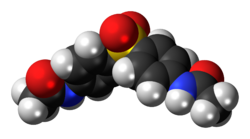Acedapsone
Appearance
 | |
 | |
| Clinical data | |
|---|---|
| Trade names | Rodilone Hansolar |
| ATC code |
|
| Identifiers | |
| |
JSmol) | |
| Melting point | 290 °C (554 °F) |
| |
| |
| | |
Acedapsone (
antimalarial
activity.
Acedapsone is the INN for diacetyldapsone. It was synthesized and developed in 1937 by Ernest Fourneau and his team in the pharmaceutical chemistry laboratory of Pasteur Institute,[1] and it was marketed as Rodilone by the Rhône-Poulenc company.[2]
It is a long-acting prodrug of dapsone. It is used for treating leprosy.[3]
It crystallises as pale yellow needles from diethyl ether, and as leaflets from dilute ethanol. It is slightly soluble in water.[citation needed]
Synthesis

Acedapsone is conveniently prepared by acetylation of dapsone.
References
- ^ Fourneau E, Tréfouël J, Nitti F, Bovet D (July 1937). "Chimiothérapie de l'infection pneumococcique par la di-(p-acétylaminophényl)-sulfone (1399 F)". Compt. Rend. Acad. Sci. (in French). 205: 299.
- .
- PMID 12862255.
- PMID 4892242.
- .
- .
